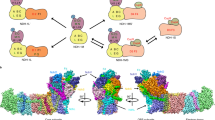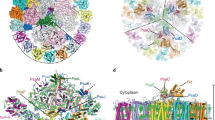Abstract
Oxygenic photosynthesis efficiency at increasing solar flux is limited by light-induced damage (photoinhibition) of Photosystem II (PSII), primarily targeting the D1 reaction center subunit. Some cyanobacteria contain two natural isoforms of D1 that function better under low light (D1:1) or high light (D1:2). Herein, rates and yields of photoassembly of the Mn4CaO5 water-oxidizing complex (WOC) from the free inorganic cofactors (Mn2+, Ca2+, water, electron acceptor) and apo-WOC-PSII are shown to differ significantly: D1:1 apo-WOC-PSII exhibits a 2.3-fold faster rate-limiting step of photoassembly and up to seven-fold faster rate to the first light-stable Mn3+ intermediate, IM1*, but with a much higher rate of photoinhibition than D1:2. Conversely, D1:2 apo-WOC-PSII assembles slower but has up to seven-fold higher yield, achieved by a higher quantum yield of charge separation and slower photoinhibition rate. These results confirm and extend previous observations of the two holoenzymes: D1:2-PSII has a greater quantum yield of primary charge separation, faster [P680 + Q −A ] charge recombination and less photoinhibition that results in a slower rate and higher yield of photoassembly of its apo-WOC-PSII complex. In contrast, D1:1-PSII has a lower quantum yield of primary charge separation, a slower [P680 + Q −A ] charge recombination rate, and faster photoinhibition that together result in higher rate but lower yield of photoassembly at higher light intensities. Cyanobacterial PSII reaction centers that contain the high- and low-light D1 isoforms can tailor performance to optimize photosynthesis at varying light conditions, with similar consequences on their photoassembly kinetics and yield. These different efficiencies of photoassembly versus photoinhibition impose differential costs for biosynthesis as a function of light intensity.






Similar content being viewed by others
References
Ananyev GM, Dismukes GC (1996) Assembly of the tetra-Mn site of photosynthetic water oxidation by photoactivation: Mn stoichiometry and detection of a new intermediate. Biochemistry 35(13):4102–4109. doi:10.1021/bi952667h
Ananyev GM, Murphy A, Abe Y, Dismukes GC (1999) Remarkable affinity and selectivity for Cs+ and uranyl (UO2 2+) binding to the manganese site of the apo-water oxidation complex of Photosystem II. Biochemistry 38(22):7200–7209. doi:10.1021/bi990023u
Ananyev GM, Zaltsman L, Vasko C, Dismukes GC (2001) The inorganic biochemistry of photosynthetic oxygen evolution/water oxidation. Biochim Biophys Acta 1503(1–2):52–68
Babcock GT, Ghanotakis DF, Ke B, Diner BA (1983) Electron donation to Photosystem II in reaction center preparations. Biochim Biophys Acta 723(2):276–286
Baranov SV, Tyryshkin AM, Katz D, Dismukes GC, Ananyev G, Klimov VV (2004) Bicarbonate is a native cofactor for assembly of the manganese cluster of the photosynthetic water oxidizing complex. Kinetics of reconstitution of oxygen evolution by photoactivation. Biochemistry 43(7):2070–2079
Blankenship RE, Sauer K (1974) Manganese in photosynthetic oxygen evolution. I. Electron paramagnetic resonance study of the environment of manganese in Tris-washed chloroplasts. Biochim Biophys Acta 357(2):252–266
Burnap RL (2004) D1 protein processing and Mn cluster assembly in light of the emerging Photosystem II structure. Phys Chem Chem Phys 6(20):4803–4809
Campbell D, Eriksson M-J, Oquist G, Gustafsson P, Clarke AK (1998) The cyanobacterium Synechococcus resists UV-B by exchanging photosystem II reaction-center D1 proteins. Proc Natl Acad Sci USA 95(1):364–369
Chen C, Kazimir Janet, Cheniae GM (1995) Calcium modulates the photoassembly of Photosystem I1 (Mn)4-clusters by preventing ligation of nonfunctional high-valency states of manganese. Biochemistry 34(41):13511–13526
Cheniae GM (1980) Manganese binding sites and presumed manganese proteins in chloroplasts, vol 69., Methods in enzymology Academic Press, New York
Cheniae GM, Martin IF (1971) Effects of hydroxylamine on Photosystem II: I. Factors affecting the decay of O2 evolution. Plant Physiol 47(4):568–575
Clarke AK, Soitamo A, Gustafsson P, Oquist G (1993) Rapid interchange between two distinct forms of cyanobacterial photosystem II reaction-center protein D1 in response to photoinhibition. Proc Natl Acad Sci USA 90(21):9973–9977
Dasgupta J, Ananyev GM, Dismukes GC (2008) Photoassembly of the water-oxidizing complex in photosystem II. Coord Chem Rev 252(3–4):347–360. doi:10.1016/j.ccr.2007.08.022
Gimpel J, Mayfield S (2013) Analysis of heterologous regulatory and coding regions in algal chloroplasts. Appl Microbiol Biotechnol 97(10):4499–4510. doi:10.1007/s00253-012-4580-4
Golden SS, Brusslan J, Haselkorn R (1986) Expression of a family of psbA genes encoding a photosystem II polypeptide in the cyanobacterium Anacystis nidulans R2. EMBO J 5(11):2789–2798
Hunziker D, Abramowicz DR, Damoder R, Dismukes GC (1987) Evidence for an association between a 33 kDa extrinsic membrane protein, manganese and photosynthetic oxygen evolution. I. Correlation with the S2 multiline EPR signal. Biochim Biophys Acta 890(1):6–14
Hwang HJ, Burnap RL (2005) Multiflash experiments reveal a new kinetic phase of photosystem II manganese cluster assembly in Synechocystis sp PCC 6803 in vivo. Biochemistry 44(28):9766–9774
Kato Y, Shibamoto T, Yamamoto S, Watanabe T, Ishida N, Sugiura M, Rappaport F (1817) Boussac A (2012) Influence of the PsbA1/PsbA3, Ca2+/Sr2+ and Cl-/Br- exchanges on the redox potential of the primary quinone QA in Photosystem II from Thermosynechococcus elongatus as revealed by spectroelectrochemistry. Biochim Biophys Acta 11:1998–2004
Kato Y, Sugiura M, Oda A, Watanabe T (2009) Spectroelectrochemical determination of the redox potential of pheophytin a, the primary electron acceptor in photosystem II. Proc Natl Acad Sci USA 106(41):17365–17370. doi:10.1073/pnas.0905388106
Kolling DRJ, Cox N, Ananyev GM, Pace RJ, Dismukes GC (2012) What are the oxidation states of manganese required to catalyze photosynthetic water oxidation? Biophys J 103(2):313–322. doi:10.1016/j.bpj.2012.05.031
Kulkarni RD, Golden SS (1994) Adaptation to high light intensity in Synechococcus sp. strain PCC 7942: regulation of three psbA genes and two forms of the D1 protein. J Bacteriol 176(4):959–965
Kuwabaraa T, Miyaob Mitsue, Murataa Teruyo, Murata Norio (1985) The function of 33-kDa protein in the photosynthetic oxygen-evolution system studied by reconstitution experiments. Biochim Biophys Acta-Bioenerg 806(2):283–289
McEvoy JP, Brudvig GW (2006) Water-splitting chemistry of photosystem II. Chem Rev 106(11):4455–4483. doi:10.1021/cr0204294
Miyao M, Murata Norio (1984) Role of the 33-kDa polypeptide in preserving Mn in the photosynthetic oxygen-evolution system and its replacement by chloride ions. FEBS Lett 170(2):350–354
Muh F, Zouni A (2011) Light-induced water oxidation in Photosystem II. Front Biosci 16:3072–3132
Mulo P, Sicora C, Aro E-M (2009) Cyanobacterial psbA gene family: optimization of oxygenic photosynthesis. Cell Mol Life Sci 66(23):3697–3710. doi:10.1007/s00018-009-0103-6
Mulo P, Sakurai I, Aro E (2012) Strategies for psbA gene expression in cyanobacteria, green algae and higher plants: from transcription to PSII repair. Biochim Biophys Acta 1817(1):247
Ogami S, Boussac A, Sugiura M (2012) Deactivation processes in PsbA1-Photosystem II and PsbA3-Photosystem II under photoinhibitory conditions in the cyanobacterium Thermosynechococcus elongatus. Biochim Biophys Acta 1817(8):1322–1330
Porra RJ, Thompson WA, Kriedemann PE (1989) Determination of accurate extinction coefficients and simultaneous equations for assaying chlorophylls a and b extracted with four different solvents: verification of the concentration of chlorophyll standards by atomic absorption spectroscopy. Biochim Biophys Acta 975(3):384–394
Sander J, Nowaczyk M, Buchta J, Dau H, Vass I, Deak Z, Dorogi M, Iwai M, Rogner M (2010) Functional characterization and quantification of the alternative psbA copies in Thermosynechococcus elongatus and their role in photoprotection. J Biol Chem 285(39):29851–29856. doi:10.1074/jbc.M110.127142
Schaefer MR, Golden SS (1989a) Differential expression of members of a cyanobacterial psbA gene family in response to light. J Bacteriol 171(7):3973–3981
Schaefer MR, Golden SS (1989b) Light availability influences the ratio of two forms of D1 in cyanobacterial thylakoids. J Biol Chem 264(13):7412–7417
Sueoka N (1960) Mitotic replication of deoxyribonucleic acid in Chlamydomonas reinhardi. Proc Natl Acad Sci USA 46(1):83–91
Sugiura M, Boussac A (2014) Some Photosystem II properties depending on the D1 protein variants in Thermosynechococcus elongatus. Biochim Biophys Acta 1837:1427–1434
Sugiura M, Boussac A, Noguchi T, Rappaport F (2008) Influence of Histidine-198 of the D1 subunit on the properties of the primary electron donor, P680, of photosystem II in Thermosynechococcus elongatus. Biochim Biophys Acta 1777(4):331–342. doi:10.1016/j.bbabio.2008.01.007
Sugiura M, Iwai E, Hayashi H, Boussac A (2010) Differences in the interactions between the subunits of Photosystem II dependent on D1 protein variants in the thermophilic cyanobacterium Thermosynechococcus elongatus. J Biol Chem 285(39):30008–30018. doi:10.1074/jbc.M110.136945
Tamura N, Cheniae GM (1987) Photoactivation of the water-oxidizing complex in Photosystem II membranes depleted of Mn and extrinsic proteins. I. Biochemical and kinetic characterization. Biochim Biophys Acta 890:179–194
Tichy M, Lupinkova L, Sicora C, Vass I, Kuvikova S, Prasil O, Komenda J (2003) Synechocystis 6803 mutants expressing distinct forms of the Photosystem II D1 protein from Synechococcus 7942: relationship between the psbA coding region and sensitivity to visible and UV-B radiation. Biochim Biophys Acta 1605(1–3):55–66
Umena Y, Kawakami K, Shen J-R, Kamiya N (2011) Crystal structure of oxygen-evolving Photosystem II at a resolution of 1.9 angstrom. Nature 473(7345):55–60
Vinyard DJ, Ananyev GM, Dismukes GC (2013a) Photosystem II: the reaction center of oxygenic photosynthesis. Annu Rev Biochem 82(1):577–606. doi:10.1146/annurev-biochem-070511-100425
Vinyard DJ, Gimpel J, Ananyev GM, Cornejo MA, Golden SS, Mayfield SP, Dismukes GC (2013b) Natural variants of Photosystem II subunit D1 tune photochemical fitness to solar intensity. J Biol Chem 288(8):5451–5462. doi:10.1074/jbc.M112.394668
Vinyard DJ, Gimpel J, Ananyev GM, Mayfield SP, Dismukes GC (2014) Engineered Photosystem II reaction centers optimize photochemistry versus photoprotection at different solar intensities. J Am Chem Soc 136(10):4048–4055. doi:10.1021/ja5002967
Zaltsman L, Ananyev G, Bruntrager E, Dismukes GC (1997) Quantitative kinetic model for photoassembly of the photosynthetic water oxidase from its inorganic constituents: requirements for manganese and calcium in the kinetically resolved steps. Biochemistry 36:8914–8922
Acknowledgments
This work was supported by grants from the National Science Foundation-Chemistry of Life Processes, CHE1213772 (to GCD), and the U.S. Department of Energy, Consortium for Algal Biofuels Commercialization, Grant DE-EE0003373 (to SPM). JSS was supported by the Waksman Institute of Microbiology and the Aresty Research Center for Undergraduates at Rutgers University. DJV was supported by the Department of Deference Army Research Office through a National Defense Science and Engineering Graduate (NDSEG - 32CFR168a), and a National Science Foundation Graduate Research Fellowship, DGE-0937373. JG was supported by the Comisión Nacional de Investigación Científica y Tecnológica de Chile (CONICYT). We thank Clyde Cady for assistance with EPR measurements.
Author information
Authors and Affiliations
Corresponding author
Rights and permissions
About this article
Cite this article
Vinyard, D.J., Sun, J.S., Gimpel, J. et al. Natural isoforms of the Photosystem II D1 subunit differ in photoassembly efficiency of the water-oxidizing complex. Photosynth Res 128, 141–150 (2016). https://doi.org/10.1007/s11120-015-0208-8
Received:
Accepted:
Published:
Issue Date:
DOI: https://doi.org/10.1007/s11120-015-0208-8




